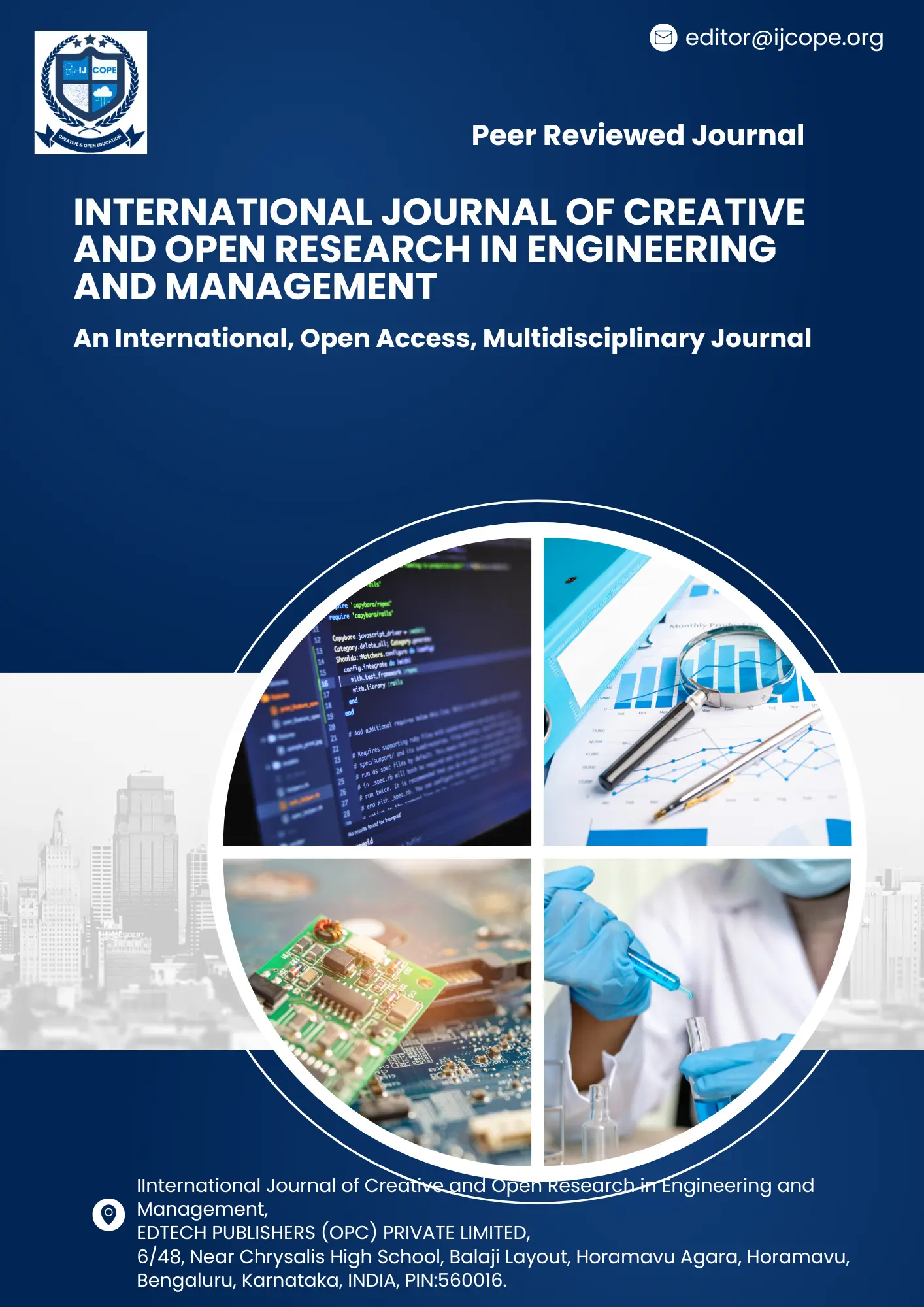Announcements
-
Peer Review Policy
Ijcope follows Strict Peer Review Policy -
Guidelines
IARJET follows double-blind peer review process to ensure high quality of Guidelines -
ISSN IS: 2583-0813
An International Open Access, Peer Reviewed Journal -
Call for Papers
July 2025. Ijcop invites all research papers for publication in Volume 4, Issue 4 -
Peer Review Policy
Ijcope follows Strict Peer Review Policy -
Guidelines
IARJET follows double-blind peer review process to ensure high quality of Guidelines -
ISSN IS: 2583-0813
An International Open Access, Peer Reviewed Journal -
Call for Papers
July 2025. Ijcop invites all research papers for publication in Volume 4, Issue 4

Submit Your Article Now
Additive Manufacturing Techniques for Lightweight Structural Components in Aerospace Engineering
Mr. Rahul Deshmukh, Ms. Sneha Kulkarni, Mr. Ajay Kumar Yadav
Mentor: Dr. Meenakshi R. Patil, Associate Professor
Department of Mechanical Engineering
MIT World Peace University,
S. No. 124, Paud Road, Kothrud, Pune – 411038, Maharashtra, India.
Abstract
Additive manufacturing (AM), commonly referred to as 3D printing, has revolutionized aerospace engineering by enabling the production of lightweight, high-performance structural components. This article comprehensively examines AM techniques, including Powder Bed Fusion (PBF), Directed Energy Deposition (DED), Fused Deposition Modeling (FDM), and solid-state processes like Ultrasonic Additive Manufacturing (UAM), focusing on their applications in creating lightweight structures such as airframe components, engine parts, and brackets. The study highlights material innovations, such as titanium alloys, nickel-based superalloys, and high-performance thermoplastics, alongside design optimization strategies like topology optimization and lattice structures. Through a systematic literature review and case study analysis, the article evaluates AM’s impact on weight reduction, fuel efficiency, and production costs. Challenges, including material certification, process scalability, and quality control, are analyzed, and future research directions are proposed. The findings underscore AM’s transformative potential in aerospace, supported by case studies from industry leaders like GE Aviation, Airbus, and Boeing, which demonstrate significant weight savings and performance enhancements.Additive manufacturing (AM) has emerged as a transformative technology in aerospace engineering, offering unprecedented capabilities in producing complex, lightweight components that were previously impossible or impractical to manufacture using traditional methods. The article delves into various AM techniques, each with unique advantages for specific aerospace applications. Powder Bed Fusion (PBF) and Directed Energy Deposition (DED) excel in creating intricate metal parts with high precision, while Fused Deposition Modeling (FDM) offers versatility in working with thermoplastics. Ultrasonic Additive Manufacturing (UAM), a solid-state process, enables the creation of multi-material structures with enhanced properties. These techniques have been instrumental in fabricating critical aerospace components, from airframe structures to engine parts, resulting in significant weight reductions and improved fuel efficiency.
The study also explores the synergy between AM and advanced materials science, highlighting the development of specialized alloys and composites tailored for aerospace applications. Titanium alloys, known for their high strength-to-weight ratio, and nickel-based superalloys, prized for their heat resistance, have been optimized for AM processes to enhance performance further. Additionally, the article examines how design optimization strategies, such as topology optimization and lattice structures, leverage AM’s capabilities to create components with optimal strength-to-weight ratios. These advancements, coupled with case studies from industry leaders demonstrating tangible benefits in weight reduction and performance enhancement, underscore AM’s potential to revolutionize aerospace manufacturing. However, the article also addresses critical challenges, including material certification, process scalability, and quality control, which must be overcome to fully realize AM’s potential in aerospace applications.
Keywords
Additive Manufacturing, 3D Printing, Aerospace Engineering, Lightweight Structures, Powder Bed Fusion, Directed Energy Deposition, Fused Deposition Modeling, Topology Optimization, Lattice Structures, Material Certification
References
- (2023). Additive Manufacturing in Aerospace Industry. [ADDiTEC Website]
- com. (2024). Top 5 examples of additive manufacturing in aerospace. [Engineering.com]
- Endeavor 3D. (2023). Additive Manufacturing in Aerospace and Defense. [Endeavor 3D Website]
- (2024). Additive Manufacturing Aerospace: Innovations and Applications. [Unionfab Website]
- (2023). Recent Innovations in Additive Manufacturing for Industrial Applications. [ResearchGate]
- Manufacturing Today. (2024). How Additive Manufacturing is Shaping the Future. [Manufacturing Today]
- (2023). Additive Manufacturing in Aerospace: 3D Printing Applications and Innovations. [Ultimaker Website]
- (2022). Advanced Manufacturing Techniques in Aerospace Engineering. [ResearchGate]
- (2024). Additive Manufacturing in Aerospace: Advantages, Applications, and Materials. [Thomasnet Website]
- Kladovasilakis, N., Kostavelis, I., Charalampous, P., Tzetzis, D., Tsongas, K., & Tzovaras, D. (2021). Experimental and Computational Investigation of Lattice Sandwich Structures Constructed by Additive Manufacturing Technologies. Journal of Manufacturing and Materials Processing, 5(3), 95. https://doi.org/10.3390/jmmp5030095
| Submission Last Date |
31/10/2025 |
| Acceptance Status |
within 6 Days |
| Paper Publish | within 5 Days |
- International Journal of Creative and Open Education
- EDTECH PUBLISHERS (OPC) PRIVATE LIMITED
- 6/48, Near Chrysalis High School, Balaji Layout, Horamavu Agara, Horamavu
- Bengaluru, Karnataka, PIN: 560016,India


